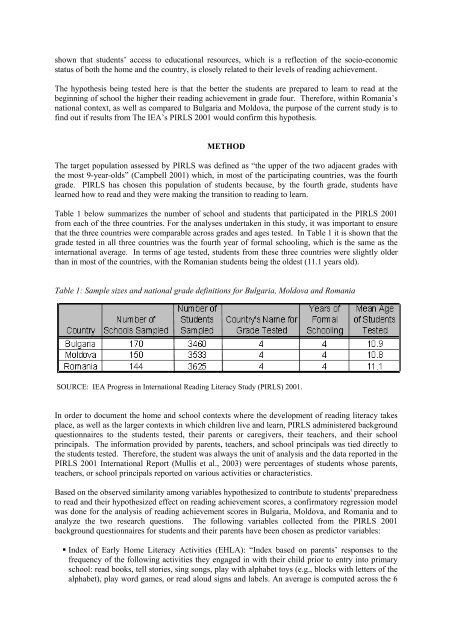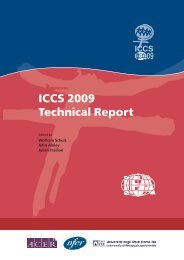THE EFFECTS OF EARLY LITERACY ACTIVITIES UPON ... - IEA
THE EFFECTS OF EARLY LITERACY ACTIVITIES UPON ... - IEA
THE EFFECTS OF EARLY LITERACY ACTIVITIES UPON ... - IEA
You also want an ePaper? Increase the reach of your titles
YUMPU automatically turns print PDFs into web optimized ePapers that Google loves.
shown that students’ access to educational resources, which is a reflection of the socio-economic<br />
status of both the home and the country, is closely related to their levels of reading achievement.<br />
The hypothesis being tested here is that the better the students are prepared to learn to read at the<br />
beginning of school the higher their reading achievement in grade four. Therefore, within Romania’s<br />
national context, as well as compared to Bulgaria and Moldova, the purpose of the current study is to<br />
find out if results from The <strong>IEA</strong>’s PIRLS 2001 would confirm this hypothesis.<br />
METHOD<br />
The target population assessed by PIRLS was defined as “the upper of the two adjacent grades with<br />
the most 9-year-olds” (Campbell 2001) which, in most of the participating countries, was the fourth<br />
grade. PIRLS has chosen this population of students because, by the fourth grade, students have<br />
learned how to read and they were making the transition to reading to learn.<br />
Table 1 below summarizes the number of school and students that participated in the PIRLS 2001<br />
from each of the three countries. For the analyses undertaken in this study, it was important to ensure<br />
that the three countries were comparable across grades and ages tested. In Table 1 it is shown that the<br />
grade tested in all three countries was the fourth year of formal schooling, which is the same as the<br />
international average. In terms of age tested, students from these three countries were slightly older<br />
than in most of the countries, with the Romanian students being the oldest (11.1 years old).<br />
Table 1: Sample sizes and national grade definitions for Bulgaria, Moldova and Romania<br />
SOURCE: <strong>IEA</strong> Progress in International Reading Literacy Study (PIRLS) 2001.<br />
In order to document the home and school contexts where the development of reading literacy takes<br />
place, as well as the larger contexts in which children live and learn, PIRLS administered background<br />
questionnaires to the students tested, their parents or caregivers, their teachers, and their school<br />
principals. The information provided by parents, teachers, and school principals was tied directly to<br />
the students tested. Therefore, the student was always the unit of analysis and the data reported in the<br />
PIRLS 2001 International Report (Mullis et al., 2003) were percentages of students whose parents,<br />
teachers, or school principals reported on various activities or characteristics.<br />
Based on the observed similarity among variables hypothesized to contribute to students' preparedness<br />
to read and their hypothesized effect on reading achievement scores, a confirmatory regression model<br />
was done for the analysis of reading achievement scores in Bulgaria, Moldova, and Romania and to<br />
analyze the two research questions. The following variables collected from the PIRLS 2001<br />
background questionnaires for students and their parents have been chosen as predictor variables:<br />
• Index of Early Home Literacy Activities (EHLA): “Index based on parents’ responses to the<br />
frequency of the following activities they engaged in with their child prior to entry into primary<br />
school: read books, tell stories, sing songs, play with alphabet toys (e.g., blocks with letters of the<br />
alphabet), play word games, or read aloud signs and labels. An average is computed across the 6
















